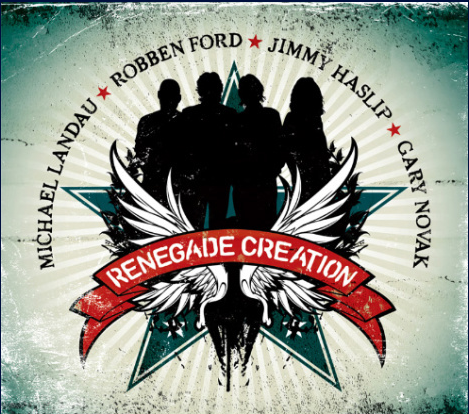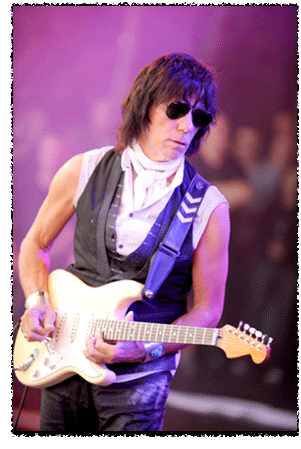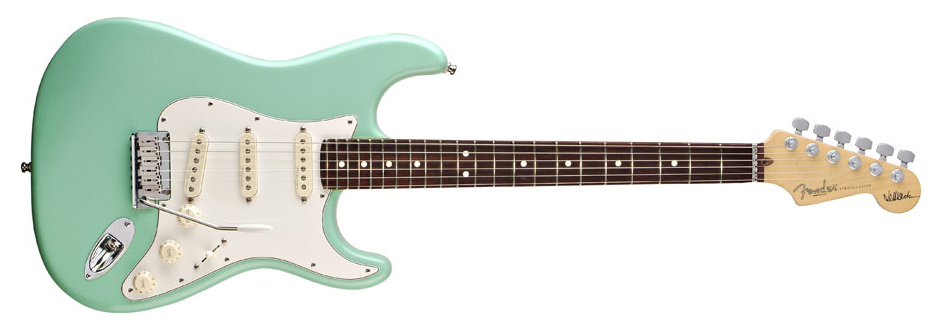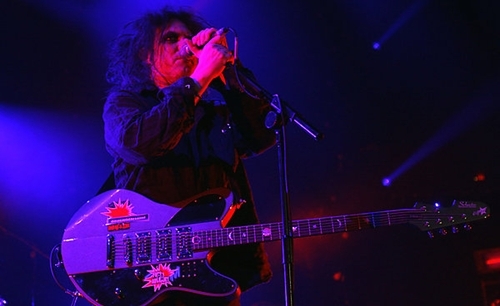After Robert Smith and Jeff Beck, I thought it was time for some virtuoso action with the almighty Joe Satriani. If you don’t know who Joe Satriani is and you play the electric guitar, you probably have been abducted by Aliens in the 70s only to be returned to earth last week (go get “Surfing with the Alien” right now).
In this post we will look into his gear and learn how to recreate the same kind of lead tone using just a few common pedals that I will demo in a video. Although his studio albums – especially since the late 90s – feature a lot of different pedals and textures, Satch has a simpler approach on stage. 90% of the time, he uses the same recipe for his tone and the rest, as always, is in the fingers.
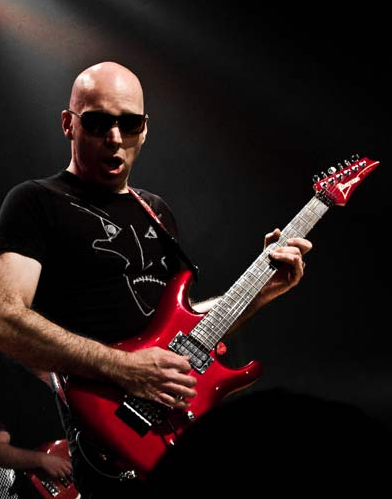
Guitars
Although he played a Kramer Pacer on “Surfing with the Alien”, Satriani quickly became an Ibanez endorser in the late eighties and remains one today. His Ibanez signature JS family of guitars has not stopped growing. The “classic” workhorse model is the JS1000. There is a more affordable version named JS100 and more esoteric models like the newly released JS2400 with 24 frets or the JS1600 without tremolo. The JS1000 that he uses the most has a bolt on neck, 2 Di Marzio custom humbuckers and a floyd rose type of blocking tremolo system with fine tuners.
As such, it is very representative of 80s “guitar technology” after Eddie Van Halen took a Stratocaster-like guitar and put a humbucker and a floyd rose on it, making it a bit of a cross between a Fender and a Gibson. The pickups were specially designed for this line of guitars and I must say I especially like the neck pickup which has a very “glassy” almost Stratocaster-like quality. On the JS1000, the humbuckers can be split to sound like single coils, pretty versatile. The blocking tremolo system allows for much abuse and Satch is a great abuser, he can get the wildest effects out of it and still stay in tune.
Amps and Effects
In the eighties, unlike many other fellow metal or rock guitarists, Satriani often did not get his big distortion tone from a super cranked Marshall boosted by some overdrive pedal. He used (and still does) distortion pedals in front of a clean amp. The BOSS DS-1 orange distortion was a very important part of his tone from the eighties all the way to about 2009 when his own VOX Satchurator distortion pedal was released. I went to his “Super Colossal” tour show in Paris in 2006 and I distinctly remember seeing him switching from clean to his signature lead tone by pressing on the little orange pedal in front of him. I am 99% sure it was a DS-1. This surprised me because it was not long after his own line of amplifiers (the Peavey JSX) had been released and there were quite a few behind him on stage. Although these amps are highly capable of providing lots of gain, he was obviously just using them clean and getting his distortion from the DS-1.
Now on the topic of the DS-1, it is loved by some and loathed by others. Some find it synthetic sounding or thin, etc. Let me tell you that it is not the kind of pedal that will sound great through any rig, it works well with some guitars and amps but can sound horrible used with others. Also, it does not have 100 sounds but one so if you love it, you’re in luck, if you don’t, you will be tempted to throw it out of the window. That said, a lot of pros use it and get great tones out of it and it has been in the BOSS catalog for over 30 years now! This controversial aspect of the DS-1 tone explains why it is one of the most modified pedals on the market. There are great mods by Analogman, Robert Keeley, Monte Allum, etc. It seems that in more recent years, Satriani was using a Keeley version (like his pal Steve Vai) although I am not finding any hard evidence of it. Update Feb 2012: in this awesome interview on musicplayers.com. Satch answers this question: “Well, I would use clean channel of the JFX. I’d get a slightly altered, vintage Boss DS-1. I can’t tell you the alteration, though, that’s a secret!“. That settles it but as far as what the alteration is, the question remains.
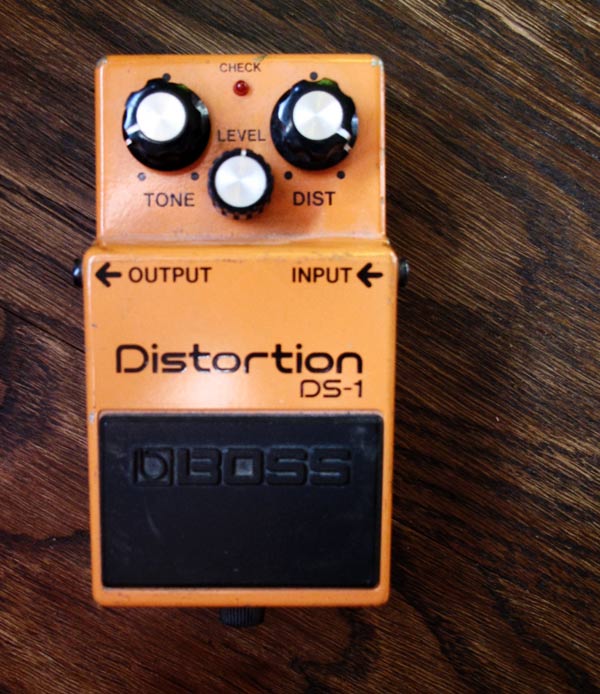
It is funny to see that tone purists on forums are quick to qualify Satriani’s tone as bad, you know the “he should use a Les Paul 59 and a bassman from 1756 instead of an Ibanez and a cheap BOSS distortion” kind of remarks. Let me tell you that I have seen lots of great guitarists on stage and Satriani’s tone is one of the best I have heard. It really serves the songs and compliments his playing.
There are two other effects that are an important part of Satriani’s tone: delay and wah. He has used up to 3 delay units in series in the 90s. He has never been a fan of rack mounted gear and all his effects were usually pedals placed in front of him. The exceptions were two rack mounted chandler delay units that he would use on top of an old BOSS DM-2 analog delay or DD-2 digital Delay (see this guitar geek entry). His settings for the three delays were interesting: the first delay was quite short, the second delay longer and the third even longer. The blending of the three gives a very spacious tone. If you don’t have three delays you can try this with your favorite recording software, this sounds a bit like a reverb without using a reverb.
In the last decade, he went back to using one good delay pedal, often an old BOSS DM-2: see photos of his 2010 experience Hendrix tour pedal board. Of course, Satch now has his own delay pedal made by VOX, the Time machine. As to wah pedals, he used an old VOX model in the early days and a few years back he was using a Jim Dunlop 535Q, but he now has his own model made by… VOX: the Big Bad Wah. This is no coincidence that the first three pedals he designed with VOX are a distortion, a delay and a wah because these are the basics of his tone. An overdrive called Ice 9 has just been announced by VOX in the same range.
On the subject of amps, as I mentioned before, he rather uses them clean. In the 90s, he was using a Marshall Anniversary head and later on switched to his own line of Peavey JSX. Apparently, he is going back to Marshall after his short stint with Peavey.
To summarize, a good wah, a distortion and a delay plugged into a good clean amp is the basis for Satriani’s tone on stage. I am not saying that it is all you need to reproduce Satriani’s every tone, I am saying that this is the recipe for the lead tone he uses live about 90% of the time, especially on classics like “Surfing with the Alien”, “Satch Boogie”, “Ice 9”, and so on. Amongst the remaining 10% of the songs, some can be heavily reliant on one particular effect like the Digitech whammy used on “Cool #9”; the Electro Harmonix POG used on “Super colossal” for that super fat tone; or the Fulltone Ultimate Octave for several other numbers. I must also mention the use of modulation effects like a BOSS CH-1 chorus, a BOSS BF-2 Flanger or a univibe clone such as the Fulltone Deja Vibe. This is especially obvious on his clean tones although his pedal board has not been consistent in that respect. Pedals come and go with the different tours and albums.
Let’s redo Satriani’s Lead Tone
For this endeavor, I have used a RMC1 Wah pedal, a stock BOSS DS-1 distortion and a BOSS DD-3 delay plugged into my trusty Fender Silverface Champ set fairly clean. I don’t have an Ibanez-style guitar so I have used my Gibson SG 61 Reissue since humbuckers are a must for Satch’s lead tone (I accept donations in the form of JS1000s 😉 ).
A pity I don’t have a floyd rose kind of tremolo, I should not have sold my shredding guitar. If there is one thing that I have discovered, it is that Satriani has an extremely clean technique (emphasis on extremely clean) that my gruff style cannot match in a million years. Also, I am not able to reproduce the super smooth legato runs that Satriani is a specialist of as I am used to picking every note. Nevertheless I sure had lots of fun getting my old DS-1 out of the closet!
The settings were:
- BOSS DS-1: DIST almost on max but not quite, LEVEL at 12 o’clock and Tone quite low at 8/9 o’clock
- BOSS DD-3: LEVEL at 10 o’clock, FEEDBACK at 12 o’clock, TIME at 2 o’clock and MODE at 800ms.
- On the amp: Volume at 3, BASS at 10 and Treble at 2.5 (the amp is fairly bright as a lot of fender amps are)

